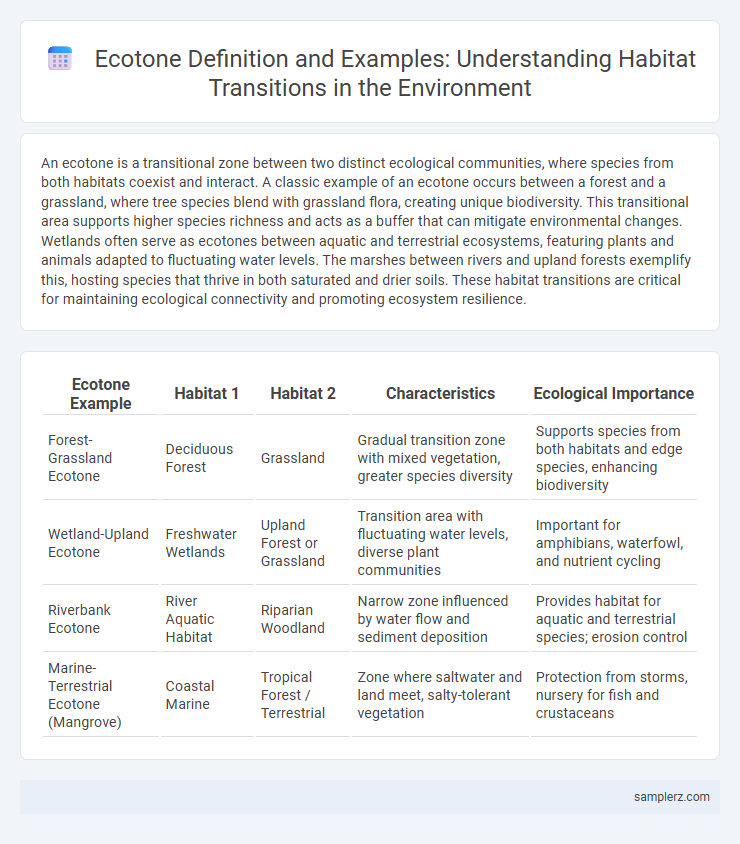An ecotone is a transitional zone between two distinct ecological communities, where species from both habitats coexist and interact. A classic example of an ecotone occurs between a forest and a grassland, where tree species blend with grassland flora, creating unique biodiversity. This transitional area supports higher species richness and acts as a buffer that can mitigate environmental changes. Wetlands often serve as ecotones between aquatic and terrestrial ecosystems, featuring plants and animals adapted to fluctuating water levels. The marshes between rivers and upland forests exemplify this, hosting species that thrive in both saturated and drier soils. These habitat transitions are critical for maintaining ecological connectivity and promoting ecosystem resilience.
Table of Comparison
| Ecotone Example | Habitat 1 | Habitat 2 | Characteristics | Ecological Importance |
|---|---|---|---|---|
| Forest-Grassland Ecotone | Deciduous Forest | Grassland | Gradual transition zone with mixed vegetation, greater species diversity | Supports species from both habitats and edge species, enhancing biodiversity |
| Wetland-Upland Ecotone | Freshwater Wetlands | Upland Forest or Grassland | Transition area with fluctuating water levels, diverse plant communities | Important for amphibians, waterfowl, and nutrient cycling |
| Riverbank Ecotone | River Aquatic Habitat | Riparian Woodland | Narrow zone influenced by water flow and sediment deposition | Provides habitat for aquatic and terrestrial species; erosion control |
| Marine-Terrestrial Ecotone (Mangrove) | Coastal Marine | Tropical Forest / Terrestrial | Zone where saltwater and land meet, salty-tolerant vegetation | Protection from storms, nursery for fish and crustaceans |
Defining Ecotones: Nature’s Transition Zones
Ecotones are dynamic transition zones where two distinct ecological communities meet and integrate, resulting in increased biodiversity and unique species interactions. Typical examples include the boundary between forest and grassland or the interface between freshwater and marine ecosystems, where environmental gradients create diverse microhabitats. These zones are essential for ecological resilience, serving as buffers and hotspots of evolutionary adaptation in response to environmental changes.
Importance of Ecotones in Habitat Diversity
Ecotones, such as the transition zone between forest and grassland, play a critical role in habitat diversity by supporting species from both adjacent ecosystems as well as unique organisms adapted specifically to the ecotone environment. This increased biodiversity enhances ecosystem resilience, promoting greater stability and productivity across habitat boundaries. The presence of ecotones also facilitates ecological processes like nutrient cycling and species migration, which are vital for maintaining healthy and functional landscapes.
Riverbanks: Classic Riparian Ecotone Examples
Riverbanks exemplify classic riparian ecotones where terrestrial and aquatic ecosystems converge, fostering high biodiversity and unique habitat conditions. These transitional zones support diverse plant species like willows and cottonwoods, which stabilize soil and provide crucial habitat for amphibians, birds, and fish. The dynamic interface regulates nutrient cycling and water quality, enhancing ecosystem resilience against flooding and erosion.
Forest-Grassland Borders: Key Transitional Areas
Forest-grassland borders serve as prime examples of ecotones where distinct ecosystems converge, creating high biodiversity and unique species interactions. These transitional zones support a mix of flora and fauna from both forest and grassland habitats, enhancing ecological resilience. The dynamic environmental gradients in these areas facilitate nutrient cycling and provide critical corridors for wildlife movement.
Mangrove-Saltmarsh Edges: Coastal Ecotone Hotspots
Mangrove-saltmarsh edges represent critical ecotone hotspots where tropical and temperate ecosystems converge, fostering unique biodiversity and ecological functions. These transitional zones enhance nutrient cycling, provide nursery habitats for various fish species, and act as buffers against coastal erosion and storm surges. Conservation of mangrove-saltmarsh ecotones is vital for sustaining coastal resilience amid climate change and rising sea levels.
Mountain-Tundra Zones: Alpine Ecotone Dynamics
The alpine ecotone represents a critical transition zone between mountain forests and tundra habitats, characterized by sharp gradients in temperature, vegetation types, and soil composition. This ecotone supports a unique assemblage of plant species adapted to cold, high-altitude conditions, including dwarf shrubs, mosses, and lichens. Ecological processes in the alpine ecotone are sensitive indicators of climate change, as shifts in temperature influence the upward migration of tree lines and alter biodiversity patterns.
Wetland-Upland Boundaries: Biodiversity Interfaces
Wetland-upland boundaries represent critical ecotones where aquatic and terrestrial ecosystems converge, fostering high biodiversity due to the availability of diverse habitats and resources. These interfaces support unique plant and animal species adapted to fluctuating moisture levels and serve as essential corridors for wildlife movement. Such ecotones enhance ecosystem resilience by facilitating nutrient cycling, water filtration, and offering breeding grounds for amphibians, birds, and insects.
Urban-Natural Ecotones: Human-Influenced Transitions
Urban-natural ecotones occur where city landscapes meet natural habitats, creating unique transition zones with mixed biodiversity and altered environmental conditions. These human-influenced ecotones often exhibit edge effects, such as increased species diversity from both urban-adapted and native species, but also face challenges like habitat fragmentation and pollution. Managing urban-natural ecotones requires integrating green infrastructure and conservation practices to maintain ecological connectivity and ecosystem services.
Desert-Savanna Transition Zones: Ecotone Adaptations
Desert-Savanna transition zones exhibit unique ecotone adaptations that enable species to thrive amid fluctuating water availability and temperature extremes. Plants such as acacias develop deep root systems to access groundwater, while animals like the desert-adapted antelope display behavioral adaptations to conserve moisture. These ecotone regions promote biodiversity by supporting species from both desert and savanna ecosystems, creating a critical habitat for ecological resilience.
Ecotone Conservation Challenges and Opportunities
Ecotones, such as the edge between forest and grassland habitats, serve as critical zones of biodiversity but face conservation challenges due to habitat fragmentation and climate change, which disrupt species migration and ecological balance. Protecting ecotones requires targeted strategies like preserving corridor connectivity and implementing adaptive management to buffer against environmental fluctuations. These efforts create opportunities for enhancing ecosystem resilience and supporting species that depend on transitional habitats for survival.

example of ecotone in habitat transition Infographic
 samplerz.com
samplerz.com